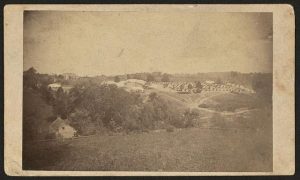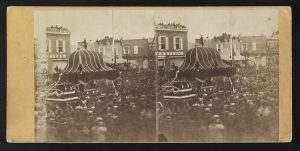The Pocket Diaries of Emilie F. Davis

Primary source documentation regarding the lives and daily experiences of black women during the Civil War and the preceding antebellum era is limited. Personal accounts of enslaved women can often only be found in the Federal Writers’ Project sponsored by the Works Progress Administration (WPA), testimonies whose accuracy has been problematic. The lives of Harriet Tubman and Sojourner Truth are notable exceptions. Amongst the population of free black women – an estimated 250,000 by 1860 – spotlights are shined on those termed as “elite” within society, meaning that they had the ability to hold a public high-profile position, had unrestricted access to education, the affluence to travel nationally or internationally, and often came from well-to-do families.[1] Diaries written by women like Charlotte Forten, Alice Dunbar Nelson, and Ida B. Welles who meet the accepted criteria, have been studied and analyzed in order to understand the lives of free black women in America. However, there is a noticeable lack of “ordinary” or “every day” free black women in historiography. This isn’t to say that free black women of middle-class or average status didn’t record their thoughts, only that so few of the primary sources have survived or have been made public. The transcribed pocket diaries of Emilie F. Davis helps to fill that void, while providing historians with a chance to study how free black people lived their lives every day in the midst of the Civil War.

Emilie was born February 18, 1838 in Harrisburg, Pennsylvania to Charles and Helena Davis. She was raised in Roxbury with her little sister Elizabeth and two brothers, Alfred and Thomas, where she was educated in a local public school. By 1860, she moved in with her uncle, Elijah Joshua Davis, his wife Sarah, and their son Elwood at 916 Rodman Street. At some point between 1860 and the first entry of her diary in 1863, she moved to the upper section of the Seventh Ward in Philadelphia, where she attended the Institute for Colored Youth, and worked both as a dressmaker (or modiste) and a domestic.[2] The Seventh Ward had the largest concentration of black wealth on the East Coast and 12% of the population was black, though Philadelphia’s public transportation system was still segregated. This community exemplified the “nineteenth-century black glitterati, a place where the feelings of tradition, hope, wealth, and privilege ran deep.”[3]
Emilie had the fortune to never experience the oppression of slavery herself, though it is clear from her pocket diary entries that she was well aware of the horrors of the institution, as Philadelphia was a hotbed of anti-slavery and abolitionist sentiment. Not only did she acquaint herself with abolitionists from some of the popular organizations of the day (Pennsylvania Anti-Slavery Society and the Philadelphia Female Anti-Slavery Society just to name a couple), she also attended lectures by well-known abolitionists like Frederick Douglas. Her pocket diaries between 1863 and 1865, filled with her sometimes faded and illegible cursive, have been painstakingly transcribed and annotated by historian Karsonya Wise Whitehead. Within her book, Emilie’s short daily entries come to life as the entries are accompanied by chapters that expound upon the experiences of free black society during the war, highlighting events like the capture of Vicksburg, the Federal victory at Gettysburg, and the assassination of Abraham Lincoln.
Most entries may appear basic, or even boring to modern standards, but what Emilie recorded and how she chose to record it speaks volumes about the free black woman lifestyle, even the lives of young, single women. For instance, the meticulous recording of the weather reflects the importance of it in their everyday lives, because if a woman didn’t own a carriage they couldn’t call on their friends and vice-versa. For a social woman like Emilie, this was a big deal. She socialized with free blacks, sympathetic whites, and former enslaved blacks who had made their way to freedom in the North. She recorded who was sick, who had died, and who got married within their community. She spoke often about shopping with her friends – Nellie was spoken of the most frequently – her progress at the Coloured Institute, attending social events, and other seemingly mundane activities that held enough personal value for her to write about them.
Some entries were subtle, but added with historical context reveals much about the feelings of free blacks in the North. Such as on June 23, 1863, Emilie simply wrote, “I feel so worried about father.” Around the same time, Confederates troops were making their way through Harrisburg, Pennsylvania, where her father lived. During that time, “hundreds of free black people were kidnapped and sold into enslavement.” In this telling entry, a mere sentence conveyed the anxieties of Northern blacks.[4]

Emilie recorded the “Soldier’s Parrade” when a flag was “presented to the Regiment by the Bannekers” on April 14, 1865, and then the following day wrote that “Very sad news was received this morning of the murder of the President. The city is in deep morning.”[7] Her feelings, as well as the feelings of the free blacks in Philadelphia is evident in her following entries, and on April 22nd,

“The President comes in town this afternoon. I went out about 3 in the afternoon. It was the grandest funeral I ever saw. The coffin and hearse was beautiful.” The next day, she struggled against the crowds to see his body until “after waiting four hours and a half” she was able to see Lincoln in state in the East Wing at Independence Hall at the Broad Street Station.[8]
Some major events of the war are overlooked, but Emilie’s everyday activities, such as going to see friends, applying for jobs, and participating in her community all give great insight into a world that is only recently being explored in further depth. Her hopes, fears, and feelings are on the page, declaring her existence in a world where people like her did not have a strong voice.
Not much is known about Emilie’s life after 1865, except that she married George Bustill White on December 13, 1866 and had five children between 1867 and 1877. Though her husband was a barber, her father-in-law was one of the wealthiest men in Philadelphia and founder of the Lebanon Cemetery (the only black-owned cemetery not attached to a church). She died the day after Christmas in 1889 from a lung and kidney infection at the age of 51.[9] Her life, to many, may not have been remarkable, but it was recorded for three years and is now a vital primary source. As the transcriber states, “Because of Emilie’s choice to keep a personal diary – her conscious act of identity assertion – she has moved from invisibility to visibility and been added to the literature on everyday, working-class free black American women.”[10]
Additional works on Emilie Davis include Emilie Davis’s Civil War: The Diaries of a Free Black Woman in Philadelphia, 1863–1865, Edited by Judith Giesberg, transcribed and annotated by The Memorable Days Project.
Endnotes
[1] Wilma King, “Our of Bounds: Emancipated and Enslaved Women in Antebellum America,” In Beyond Bondage: Free Women of Color in the Americas, edited by David Barry Gasper and Darlene Clark Hine, Urbana, University of Illinois Press, 2004, p. 128
[2] Karsonya Wise Whitehead, Notes from a Colored Girl: The Civil War Pocket Diaries of Emilie Frances Davis, University of South Carolina Press, p. 10
[3] Ibid, p. 9
[4] Ibid, p. 39
[5] Ibid, p. 44
[6] Ibid, p. 93
[7] Ibid, p. 186
[8] Ibid, pp. 186-187
[9] Ibid, p. 216-217
[10] Ibid, p. 1

Sherita, thank you for this little gem from Ms. Davis … to your point on the WPA interviews, current historians take much more liberal view of their value as primary sources … specifically, Stephanie Rogers-Jones in They Were Her Property and Daina Ramey Berry in The Price for Their Pound of Fkesh make great use of these interviews done in the 1930s …thanks again.
Hey Mark. Glad you liked the article! I admire the work of the two authors you mentioned and their use of the WPA testimonies is completely valid. My reference in the post pertained more to those interviews which may have been compromised by circumstances. Some former enslaved interviewees may have been approached by white men or women who were decedents of enslavers, and therefore may not have offered a completely candid and honest interview for the record. Trust between the races in that era were still incredibly strained. They might have sugarcoated or made light of experiences that should not have been presented in that way. I’ve heard from other historians that the WPA interviews should be carefully considered in the light of this possibility, not to throw them out altogether. They are definitely still a useful primary source for those who study this aspect of the antebellum and Civil War eras.
Good points